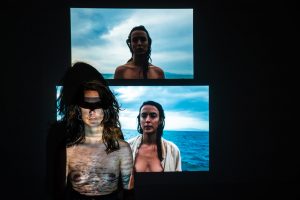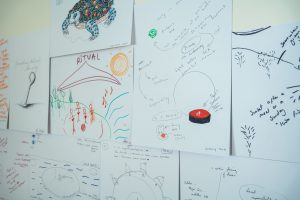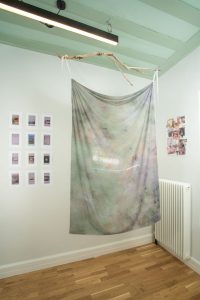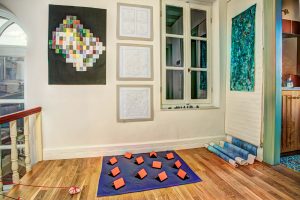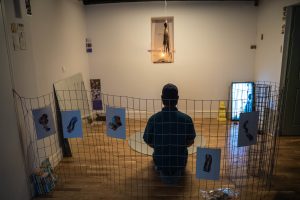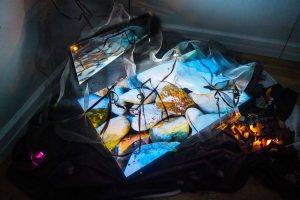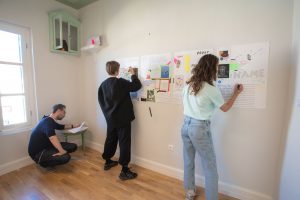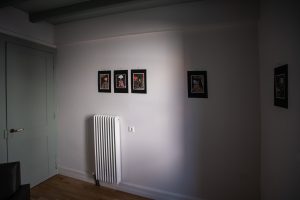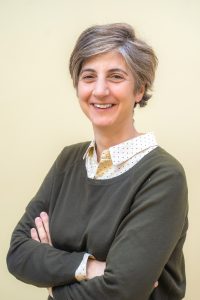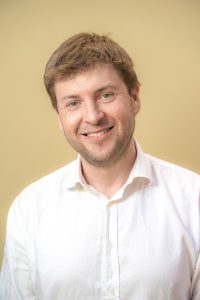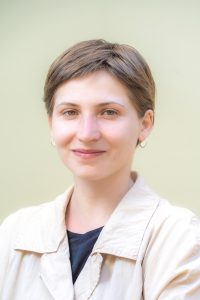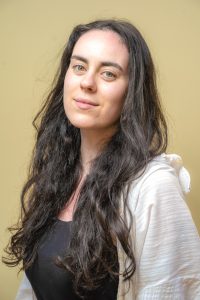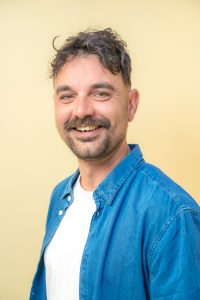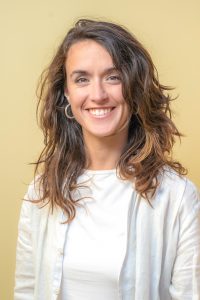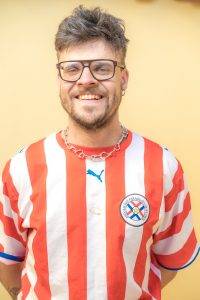Swaeny Nina Kersaan
Swaeny Nina Kersaan is an avatar artist and visual writer who explores digital culture through illustration, digital media, role-play, and the commodification of digital self-representation. With a background in graphic design, conceptual art, and a Master's in Art and Visual Culture, Swaeny Nina's work is influenced by counter-theory and is neither limited by medium nor location. Currently, she travels Europe with her participatory multi-media project "Proxy, This Is Not A Performance” [swaenynina.com]
Angelica Marinescu
Ph.D. in Sociology & Communication Sciences (University of Bucharest, Romania, University of Burgundy, France). Currently, an associated researcher at the Institute of Sociology, Romanian Academy, Bucharest, and a lecturer at the Faculty of Journalism and Communication Sciences, University of Bucharest. Previously, a lecturer at the Faculty of Sociology and Social Work, and a researcher within the Villa-Noël CEREFREA (Centre Régional Francophone d'Études Avancées en Sciences Sociales), coordinator of CRU (Centre de Réussite Universitaire), a project of AUF-BECO (Agence Universitaire de la Francophonie), University of Bucharest. From 2017 to 2020, a scholar of the Indian Council for Cultural Relations, Government of India, training in Indian classical dance. Projects and publications on: media studies, online communities and networks, Romanian rural communities, art sociology, Indian studies (diaspora, indigenous communities, Buddhist studies, dance studies), Asian studies (heritage studies, South Korea), sociology and anthropology of food. Interested in the interference between visual and performative arts; working currently on projects exploring the intersection between (new) media (networks), art and
body representation(s) [angelicamarinescu.wordpress.com].
Claudio Beorchia
Claudio Beorchia is an Italian interdisciplinary artist, increasingly working through relational and participatory practices. He studied Design and Visual Arts at Iuav University in Venice and at Brera Fine Arts Academy in Milan. He holds a Ph.D. in Design Sciences at Iuav University Doctorate School. Through commissions, awards and residency programs he developed and showed his projects on numerous occasions in Italy and abroad, usually working with museums and cultural organizations. He participated in about thirty residencies, many in Italy, as many in Europe, but also in the United States, China and Japan [www.claudiobeorchia.it]
Margerita Pulè
Margerita Pulè is a curator, researcher and artist, with a multidisciplinary and collaborative practice. In 2018 she founded Unfinished Art Space, an independent and nomadic space showing contemporary art in Malta, creating it out of a need for supportive and risk-taking spaces for artists in Malta. She is also a founder-member of the Magna Żmien Foundation, a community project which digitises 20th century analogue home archives, forming a community archive accessible to researchers and artists. Before this, she programmed much of the European Capital of Culture community programme for Valletta 2018, something that has inspired her work in genuine community-building and providing support for practicing artists [www.unfinishedartspace.org].
Tomasz Mielnik
Tomasz Mielnik studied art history at the University of Wrocław and film directing at FAMU in Prague, where ηε graduated with the feature film JOURNEY TO ROME (premiere at Karlovy Vary IFF). He is currently preparing for the film GREGORIUS, THE CHOSEN ONE, a dark comedy about a sinner who will become a pope. With this text, he was selected for the ScriptEast program and Sofia Meetings market. The project has already been supported by The Czech Film Found for production and is in the phase of international financing.
Csilla Bartus
Csilla Bartus is a multidisciplinary artist from Romania (b.1996), currently based in Budapest. She holds an MA degree in graphic art and a minor in psychopedagogy, and has refined her skills in design, digital art, and event organization through internships and work experiences in Berlin and Budapest. Her artistic approach is both poetic and analytical, exploring subjects such as posthumanism, post-internet culture, and the Anthropocene. Csilla examines environmental, human, and non-human conditions, with a focus on transformations, migration, survival, adaptability, and resilience. Using digital, physical, and illusionary experiences and techniques, she creates installations that honour and critique our relationship with the environment and technology, inviting viewers to engage in deeper reflection. Her work has been exhibited in various cultural events.
Patrycja Plich
Patrycja Plich is a transmedia artist, social designer and activist, working with the problematic of global landscapes of crisis. Using the drawing as a critical geography research where it's possible to connect digital trace and contextualized trajectories with movement – combining it with walking practice as a research tool. Confronted on the use of creative possibilities coming from crisis, where new collective topographies (also those virtual and formally intangible) can appear. Member of the trade union fighting for women rights in culture. Founder of Wanderland platform – long lasting cross-cultural project connecting Senegal, Poland and Marseille, educative initiative Kobalt migrating platform and eco-design project Wastebooks [https://patrycjaplich.tumblr.com]
Filipa Branco Jaques
Filipa Branco Jaques is a multidisciplinary artist from Évora whose career includes music, drawing, animation, performance, and sound sculpture installations [https://filipajaques.wixsite.com/ohmyohmy]. Graduated in Fine Arts-Multimedia at the Faculty of Fine Arts of the University of Porto. She is the author of the album "âmago" and most recently “Gone Soul”, among others, of her music project fibrja [https://fibrja.bandcamp.com/]. Integrates the project um, dois, trio - creation of the Associação PédeXumbo -, and collaborates with Miguel Jaques' musical project. She works in the Educational Service of the Eugénio de Almeida Foundation. Filipa has collaborated with institutions such as Pointlist, Galeria Sismógrafo, ExQuorum, and more recently Materiais Diversos with the project "em espera" [https://dentesdeleao.pt/en/cycle-of-participatory-arts/].
Paolo Lolicata
Paolo Lolicata is a Sicilian artist and curator working with an interdisciplinary and cross-cultural philosophy aiming to unfold identity preconceptions. He studied Performing Arts and a BA in DAMS at Link University in Rome. In Melbourne he founded LOLICU, a project exploring the convergence between artisan work and artistic practice to explore social concerns such as migration, reuse, masculinity and gender identity through a single symbolic fashion accessory: bowties. The project was accepted by the Incubator of Queensland University of Technology in Brisbane and distributed in stores worldwide. The opportunity to exchange with several communities in Australia led Paolo to create The Fusion People Project exploring projects to empower cross-cultural communication with a strong focus on food as a medium and the younger generations as an audience. In collaboration with the IIC and the Italian Consulate in Osaka he developed Sicilia Fusion Japan, a year-long program of cultural exchange involving artists, chefs, students and professors in both Sicily and Japan. He returned to Europe for a Master in Curatorship in Turin and to study Graphic Design in Berlin. He collaborates as independent curator at Paratissima in Turin where he won Best Curatorial project in 2019 with Human Touch. In 2020 he curated ISOLATION, a residency project in Sicily, hosted by the Municipality of Milazzo and Salina Island's Lighthouse Museum. In 2022 he took part in Duplex AIR program in Lisbon, exploring curatorship as an artistic practice. In the same year, he curated in between we swim by Nathalie Mei during Lisbon Art Weekend at PADA studios. Paolo is currently developing Universal Harmonization, a nomadic project at the intersection between rituals, communities and art making focusing on the healing potential of art. The project was recently hosted at Moagem, Portugal. He is in the process of developing OBRIGAD+ISSIMO in Lisbon founded by Culture Moves Europe. Taking inspiration from the shared Italian and Portuguese celebration of Liberation Day on the 25th of April, the research aims to unfold the concept of Liberation as a collective, personal, emotional and ethical multi-layered sociocultural process entangling history to perspectives on contemporary society. On The Move recently selected Paolo to represent Sicily in the Cultural Mobility workshop in Tunisia focused on empowering cultural exchange in the South Mediterranean area.
Alba Raventós
Alba Raventós is a performer & somatic artist born in Tarragona. She graduated in Occupational Therapy from the Autonomous University of Barcelona, completes a Postgraduate Degree in Integrative Body Work at the National Institute of Physical Education of Catalonia in 2013, and, right after that, a training in Basal Stimulation. Subsequently, she graduates as a Somatic Educator in Body Mind Centering in Germany in 2016. She starts a non-formal dance education travelling along europe and starting a festivals with dance work in Barcelona; doing intensive work Improvisation and Contact Improvisation. From 2016 she co-direct with Uma Maraval Ara En Moviment association, where the first international festival for the arts of movement (Barcelona New Year Dance Festival) is organized. In 2017 the first edition of the summer festival (Barcelona Dance in Summer) is presented. Both events are held annually to date. Since the early stages of the association, together with Uma Maraval and Adrià Sonet, she facilitates the residential training program, co-financed by Erasmus+, focused in somatic practices, movement and dance for educators who work with groups of adults and youngsters. To date, it has been held in Catalonia and in various European countries.. Collaboration with Mercat de les Flors to make contemporary dance project called Mapa De Ball from well-known coreographers based on Barcelona, arrive in highschools creating a performance after 3 months of artwork. 2 years in a road with teenagers participating in this project. As a member of Colectivo Deria Rectificadora, she co-creates the piece Topless America, a performance with a poetic-feminist spirit, shown at L’Estruch, Antic Teatre, Soma, Contemporanis de la Barceloneta, Asturias Contact Festival and MoveFest. In 2021 she creates El Timo, a piece which integrates performance and thought, a hybrid reflection on culture, history and the body, where she combines song, philosophy and movement. El Timo was created from the postpandemic need and was showed in Catalonia, Nowadays, she continues to explore body and dance in laboratories and creation processes, as well as intensives on Contact Improvisation and contemporary dance, while working as a Body Mind Centering teacher, offering intensive courses and classes on a weekly basis [araenmoviment.org/en/we-are]
Nine Fumiko Yamamoto-Masson
Nine Fumiko Yamamoto-Masson is a Japanese-French interdisciplinary artist, researcher, translator, community organiser, activist. She focuses on regimes of knowledge and gendered necropolitics of Japanese, European, U.S. (neo-)imperialisms and their intersections. Her work, deeply rooted in anticolonial feminist abolitionism, highlights networked resistance, transformation, especially art as a method of counter-knowledge in internationalist-antiimperialist alliances against hegemonic historical revisionist narratives. Her artistic research and practices fluidly embrace many methods and forms (drawing, photography, installation, sculpture, social practice, performances, collage, writing, sound, video, curating...), always grounded in solid research, conceptual approaches informed by theory, animated by poetry, playfulness, holding space for the unspoken. [nineyamamotomasson.com]
Jiří Gruber Born
Jiří Gruber Born 1992. Works as an intermedia artist, curator and educator. He studied at the Faculty of Arts MU and FaVU BUT in Brno and AVU in Prague. He also completed internships at HfG in Karlsruhe, Tirana ArtLab in Albania and Kvaka 22 in Serbia. In his creative and theoretical practice, he deals primarily with critical reflection on the institutional nature of contemporary art, power levels of language but also on aspects and consequences of the penetration of digital technologies into our everyday lives. Currently active in Prague and Ostrava.
